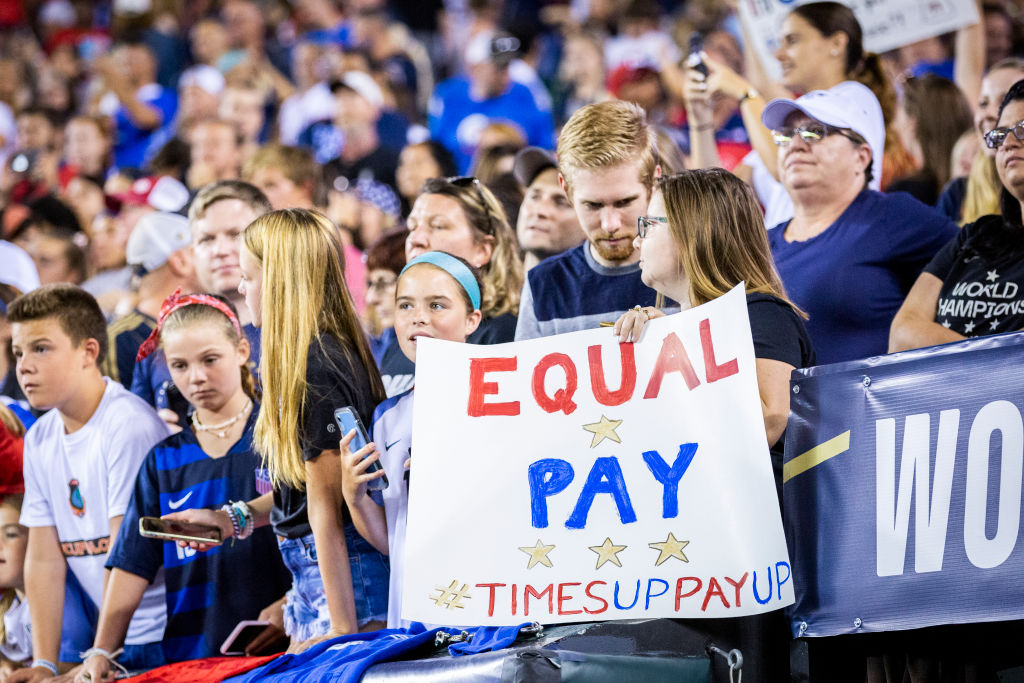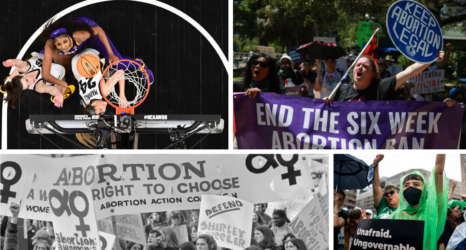
Women athletes got a big win last month when the U.S. Women’s National Team (USWNT) won a $24 million dollar legal settlement against the U.S. Soccer Federation for discrimination and unequal pay. The women had won the World Cup in 2019 and made about $250,000 each in prize money. The U.S. Men’s National Team—which did not qualify for the World Cup—would have made a little over $1.1 million each if they had won.
Last month’s landmark legal victory placed women athletes on an equal footing with their male counterparts. But true equality will never be reached unless women in all fields, with men’s support, are willing to finally stand up for themselves and collectively demand equal pay across all professions.
USWNT’s victory comes after decades of work by endless numbers of women to help the public recognize women as equally worthy. One of the most vivid examples was in 1973 when Billie Jean King beat Bobby Riggs at tennis in the “Battle of the Sexes” in support of Title IX legislation and women’s equal opportunities in sports. She won a record 20 Wimbledon titles, and led an uprising of underpaid female tennis players to demand fairer treatment and compensation. Fifty-nine million people watched that match on television. Still, the lesson wasn’t learned by those who control the money, and women had to continue to fight for equal pay.
In 2005, Venus Williams pushed Wimbledon and the French Open to offer equal pay to players. Eleven years later in 2015, Serena Williams only got $495,000 compared to $731,000 for Roger Federer’s Grand Slam Tennis win.
Industries which employ mostly women have been hit the hardest by COVID. Women, particularly women of color, have lost 5.4 million jobs—nearly 1 million more than men.
While the USWNT settlement suggests progress in the world of sports, inequities for women in the rest of society remain. For countless women, the economic disparities have been magnified by the pandemic. Women’s labor force participation is currently at a 33-year low. Jobs lost, reduced work time and limited unemployment benefits have taken a toll, particularly on women. Increased childcare and domestic duties have added to the pressure.
Reports indicate that in the U.S., 96 million people are currently in extreme poverty and over half of them are women. Industries which employ mostly women have been hit the hardest by COVID. Reports indicate that women, particularly women of color, have lost 5.4 million jobs, nearly 1 million more than men. The impact is not just on blue-collar jobs but also on the so-called “critical workers.”
In the healthcare profession, 70 percent of frontline workers and first responders are women and there is already a 28 percent pay gap compared to their male counterparts. A survey of 40,000 full time U.S. physicians conducted between January and October 2021 found that male physicians made an average of 28.2 percent more (over $122,000 more annually!) than their female peers.
All of us, including men, need to stand up for equality. Closing the gender pay gap may have a big economic benefit for everyone. According to the Institute for Women’s Policy Research, the poverty rate for women would be cut in half if women earned as much as men. Providing equal pay to women would also have a dramatic impact on their families.
Approximately 25.8 million children would benefit from the increased earnings of their mothers. Beyond wages alone, simply increasing women’s numbers in the workforce can increase the bottom line for businesses according to the International Monetary Fund, which also estimates that the GDP for the U.S. could increase by as much as 5 percent.
This year, for the first time, 86 percent of U.S. adults admitted that men and women are equally intelligent, compared to only 35 percent in 1946.
During the pandemic, school, daycare and even some long-term care closures shifted more caregiving work to women. The lack of infrastructure to support and pay for basic services uncovered the fact that the results disproportionately fell on women. The impact of these burdens is not only on the physical and mental health of women, but also threatens their educational and social potential. Equal access to jobs and economic opportunities is one thing, but family-friendly policies like paid parental leave and affordable childcare benefit everyone.
There were high hopes that Build Back Better would pass and help Americans struggling in the pandemic by addressing disparities of childcare and support for caregivers. However, congressional gridlock led to a failure to provide support for these most crucial workers.
The Equal Pay Act of 1963 made it illegal to pay women less than men for the same work, but here we are in 2022 and little has changed. Women still earn less than men for the same work. Since government is moving slowly to address the problems, how can we fix the pay gap?
One way is playing soccer as good as the USWNT soccer team—but that’s out of reach for most of us. We could learn to negotiate harder. Studies have shown that women negotiate raises and starting salaries less often than men. Women have to get rid of the imposter syndrome, and believe that they are qualified to get that raise. Employers need to be compelled to be transparent about salaries, and ensure that men and women are paid equally for doing similar work and implement standardized pay scales based on productivity and experience companywide.
A fair minimum wage, broader view of hiring/promotion qualifications for leaders, and better use of networking, all help narrow the gap. These ideas and more have been proposed before to level the playing field for women. So why is it so difficult to reach parity?
The good news is that some things have actually changed. According to a report in American Psychologist, researchers tracked responses of more than 30,000 US adults from 1946 to 2018, and found that, for the first time, 86 percent of U.S. adults admitted that men and women are equally intelligent, compared to only 35 percent in 1946. There has been a huge shift in attitudes. More women than ever are becoming educated and participating in the labor force. In this new economic climate, we should also be cognizant of the younger generation that has a very different view of what a job means. They are more likely to expect equality in their private and professional lives and demand a healthy work-life balance in their employment.
Maybe it is time to revisit the Equal Rights Amendment to insure that women are treated equally and fairly in all areas of society, including the workforce. As in the 1970s, when the ERA was proposed, members of the USWNT were willing to stand up publicly for their equal rights. They endured vitriolic responses and name-calling, including from a sitting U.S. president. We all must learn from their example. It will be a fight, but right is on our side. We need to be ready to march again for equality and for future generations of women. This time, men need to join the call for equality. After all, it benefits them, too.
Up next:





